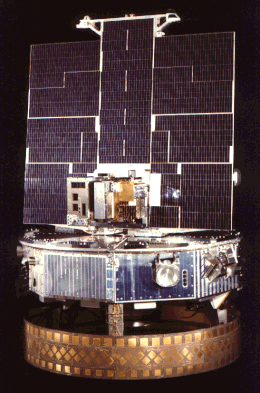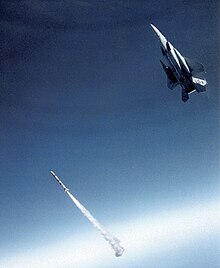 The P78-1 The P78-1 | |
| Mission type | Solar physics |
|---|---|
| Operator | DoD Space Test Program |
| COSPAR ID | 1979-017A |
| SATCAT no. | 11278 |
| Mission duration | 6 years, 6 months, 20 days |
| Spacecraft properties | |
| Manufacturer | Ball Aerospace |
| Launch mass | 1,331 kilograms (2,934 lb) |
| Dry mass | 850 kilograms (1,870 lb) |
| Start of mission | |
| Launch date | February 24, 1979, 08:24:00 (1979-02-24UTC08:24Z) UTC |
| Rocket | Atlas F-OIS |
| Launch site | Vandenberg, SLC-3W |
| End of mission | |
| Disposal | Destroyed by ASAT |
| Destroyed | September 13, 1985 (1985-09-14) |
| Orbital parameters | |
| Reference system | Sun-synchronous |
| Regime | Low Earth |
| Eccentricity | .0022038 |
| Perigee altitude | 515 kilometres (320 mi) |
| Apogee altitude | 545 kilometres (339 mi) |
| Inclination | 97.6346° |
| RAAN | 182.5017 |
| Argument of perigee | 99.6346 |
| Mean anomaly | 260.9644 |
| Mean motion | 15.11755304 |
| Epoch | 1985 09 13.72413718 |
| Instruments | |
| Gamma-ray spectrometer, a white light spectrograph, an extreme ultraviolet spectrometer, a high latitude particle spectrometer, an aerosol monitor, and an X-ray monitor | |
P78-1 or Solwind was a United States satellite launched aboard an Atlas F rocket from Vandenberg Air Force Base in California on February 24, 1979. The satellite's mission was extended by several weeks, so that it operated until it was destroyed in orbit on September 13, 1985, to test the ASM-135 ASAT anti-satellite missile.
Construction and payload
The satellite's Orbiting Solar Observatory (OSO) platform included a solar-oriented sail and a rotating wheel section. Ball Aerospace was the primary contractor for design and construction, and provided the attitude control and determination computer programs. The P78-1 carried a gamma-ray spectrometer, a white-light coronagraph, an extreme-ultraviolet imager, an X-ray spectrometer, a high-latitude particle spectrometer, an aerosol monitor, and an X-ray monitor. The X-ray monitor, designated NRL-608 or XMON, was a collaboration between the Naval Research Laboratory and Los Alamos National Laboratory. The white-light coronagraph and the ultraviolet imager were combined in a single package, designated NRL-401 or SOLWIND, which was built by the Naval Research Laboratory. The coronagraph was the flight spare of the white-light coronagraph on the OSO-7 satellite. The ultraviolet imager used a CCD imager, one of the first uses of a CCD in space.
Discovery of comets
P78-1 was the first satellite in space to discover a comet in general and a sungrazing comet in particular. In total, 9 sungrazing comets, all belonging to the Kreutz group, were discovered on images taken by the Solwind coronagraph:
| Designation | Solwind # | Image date | Discovery date | Discoverer |
|---|---|---|---|---|
| C/1979 Q1 (Solwind) | 1 | Aug 30 1979 | Sep 1981 | R. Howard, N. Koomen and D. J. Michels |
| C/1981 B1 (Solwind) | 2 | 27 Jan 1981 | D. J. Michels, N. Sheeley, O. Roberts, and F. Harlow | |
| C/1981 O1 (Solwind) | 3 | 20 Jul 1981 | D. J. Michels, R. Seal, R. Chaimson, and W. Funk | |
| C/1981 V1 (Solwind) | 4 | 4 Nov 1981 | D. J. Michels, R. Seal, R. Chaimson, and W. Funk | |
| C/1981 W1 (Solwind) | 7 | 20 Nov 1981 | 30 Jun 2005 | Rainer Kracht |
| C/1983 N2 (Solwind) | 8 | 7 Jul 1983 | 19 Jul 2005 | Rainer Kracht |
| C/1983 S2 (Solwind) | 6 | 25 Sep 1983 | R. Howard, M. Koomen, D. Michels, and N. Sheeley | |
| C/1984 O2 (Solwind) | 5 | 28 Jul 1984 | N. R. Sheeley, Jr., R. Howard, M. Koomen, and D. Michels | |
| C/1984 Q1 (Solwind) | 9 | 23 Aug 1984 | 22 Jul 2005 | Rainer Kracht |
Apart from these yet another comet C/1984 R1 (Solwind) was found by Rainer Kracht, a German amateur astronomer, on 23 July 2005 in Solwind's images of 17 Sep 1984. Its perihelion distance of 0.1051 AU was at least ten times larger than that of the previously found true sungrazers.
| Designation | Solwind # | Image date | Discovery date | Discoverer |
|---|---|---|---|---|
| C/1984 R1 (Solwind) | 10 | 17 Sep 1984 | 23 Jul 2005 | Rainer Kracht |
Destruction

By 1985, the satellite's batteries were decaying. This caused more and more frequent "under-voltage cutoffs", a condition where the satellite detected a low main bus voltage and automatically shut down all non-vital systems. In addition, the last of the three tape recorders failed in the spring of 1985, so data collection could only occur while the spacecraft was in contact with a ground station. A normal contact lasted only about 15 minutes, so this was a serious impediment. Special arrangements could be made to string several contacts together. As a result of these failures, an ever-increasing amount of time and network resources were spent reconfiguring the satellite for normal operation. Data collection from the few remaining payloads was severely limited. Because of the additional burden on the Air Force Satellite Control Network (e.g., extra support and antenna time at the tracking stations), discussions were already underway to terminate the mission.

This led to the satellite being chosen as a test target for an ASM-135 ASAT anti-satellite missile. The mission was extended for several weeks solely to support the test. During this final phase, the satellite was often allowed to remain in the under-voltage condition for several days at a time.
On September 13, 1985, the satellite was destroyed in orbit at 20:43 UTC at 35°N 126°W / 35°N 126°W / 35; -126 with an altitude of 525 kilometres (326 mi) by an ASM-135 ASAT launched from a US Air Force F-15 Eagle fighter aircraft. The test resulted in 285 cataloged pieces of orbital debris. 1 piece of debris remained in orbit to at least May 2004, but had deorbited by 2008. The last piece of debris, COSPAR 1979-017GX, SATCAT 16564, deorbited 9 May 2004 according to SATCAT.
The test outraged some scientists because although five of P78-1's instruments had failed at the time of the test, two instruments remained in operation, and the satellite was what one solar physicist called "the backbone of coronal research through the last seven years".
See also
References
- ^ Krebs, Gunter. "Solwind (P78-1)". Gunter's Space Page. Retrieved March 20, 2014.
- ^ McDowell, Jonathan. "SATCAT". Jonathan's Space Pages. Retrieved March 20, 2014.
- ^ "Solwind". Encyclopedia Astronautica. Archived from the original on June 24, 2014. Retrieved March 20, 2014.
- ^ "The P78-1 Satellite". NASA Goddard Space Flight Center. June 26, 2003. Archived from the original on October 1, 2006. Retrieved March 20, 2014.
- ^ History of On-Orbit Satellite Fragmentations (PDF) (14th ed.). NASA Orbital Debris Program Office. May 2008. pp. 15, 144.
- Space Test Program P78-1 at Ball Aerospace
- ^ Kracht, Rainer. "My Solwind Comets". Homepage von Rainer Kracht. Retrieved 2024-10-08.
- Kronk. "The Sungrazing Comets SOLWIND". G A R Y W. K R O N K ' S C O M E T S & M E T E O R S H O W E R S. Retrieved 2024-10-08.
- History of On-Orbit Satellite Fragmentations (PDF) (13th ed.). NASA Orbital Debris Program Office. May 2004. pp. 12, 136.
- Eberhart, Jonathan (Sep 28, 1985). "ASAT target was working research satellite". Science News. 128 (13): 197. doi:10.2307/3970241. JSTOR 3970241.
External links
- NASA page about the satellite Archived 2012-02-10 at the Wayback Machine
- List of research papers based on P78-1 observations
- Air Force Link, Milestones Thursday, January 01, 1970 – Sunday, December 31, 1989 at archive.today (archived July 19, 2012)
- Encyclopedia Astronautica Solwind Page
| Solar space missions | |
|---|---|
| Current |
|
| Past |
|
| Planned |
|
| Proposed | |
| Cancelled | |
| Lost | |
| Sun-Earth | |